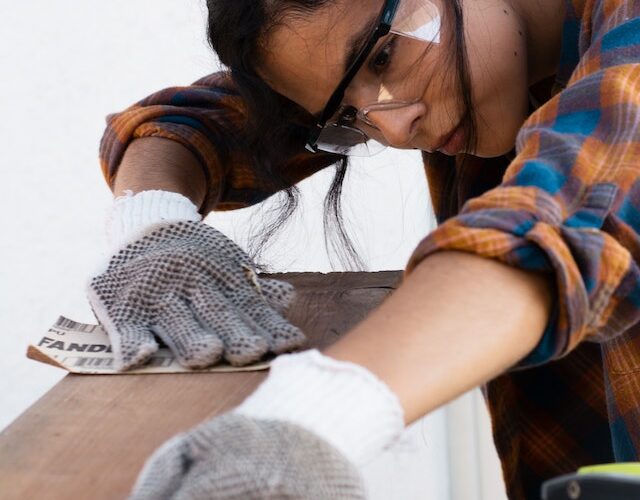Wood finishes come in many forms, but all contain some liquid that can be poured, wiped, brushed, sprayed, or rubbed onto the wood. This liquid contains both solvents and solids. The solvents will evaporate, leaving behind the solids that transform the wood from dry and delicate to rich and durable.
Don’t Over-Stain
A common problem occurs when the wood is stained too thickly. This often happens when you use a penetrating stain, which needs to soak into the wood’s pores to be effective. Applying it too thick builds up on the surface instead of soaking into the pores, leaving a tacky finish.
One of the wood finishing tips is when applying a stain, always apply a thin coat. This will help the color penetrate properly and make it easier to wipe away excess before it dries. The best way to ensure you don’t over-stain is to test the stain on scraps before applying it to your project.
Another common cause of over-staining is using too fine or worn-out sandpaper. Wood absorbs stains through its pores, so if the pores are closed by polishing or using too fine sandpaper, it won’t be easy to get an even color.
Testing the stain in a well-lit area and on scrap wood is also important before committing to it for your project. Use a brush, cloth, or sprayer to apply the stain, and wear protective gloves and safety glasses. Stains and finishes contain solvents that evaporate, releasing toxic fumes. Always work in a well-ventilated area, and keep your area clean by covering it with drop cloths or newspaper.
Don’t Over-Sand
When using a film-building finish (polyurethane, lacquer, shellac), applying multiple coats of product is important. Each layer will provide more moisture resistance and durability than the last. There is a big jump in protection and durability from coats #1 to #2 and #2 to #3.
This process may take several days, depending on your finish. It is important to keep your work area well-ventilated, follow the recommendations printed on the product container, and wear proper safety equipment, such as gloves, protective goggles, and a respirator with organic vapor cartridges.
If you accidentally sand too much, you can ruin your wood project by making it dull and lifeless. You can fix this by re-sanding the defective area with a finer grit, such as 120 or 220 grit. Be sure to sand with the grain and remove dust nibs before applying your next coat.
Penetrating finishes (like linseed and tung oils) can bring out the color in your wood while adding depth and sheen. These oils will not build a hard surface like urethanes and varnishes. It is very easy to apply these products by wiping them on, letting them set for a while, and then wiping them down to a dull sheen.
Don’t Apply Multiple Coats
Stains and finishes contain chemicals and solvents that evaporate, releasing toxic fumes. These fumes can damage your lungs, so it’s important to follow safety guidelines when handling wood stain and finish. You should wear gloves, long pants, closed-toe shoes, a long-sleeved shirt, and a mask to protect your skin, eyes, and lungs while working on wood finishing projects. It’s also a good idea to work in a well-ventilated area.
Once you’ve sanded the surface of your wood project and filled imperfections with filler, it’s time to apply a wood finish. The primary function of a wood finish is to provide a protective layer that guards the surface against scratches, chemical abrasions, moisture, and other environmental factors.
When choosing a clear finish for your wood, you must consider trade-offs between appearance, protection, durability, and cleaning requirements. Some of the most common clear wood finishes include shellac, polyurethane, lacquer, and Danish oil.
When applying wax, shellac, or other penetrating finish, you should start by wiping a liberal first coat over the entire surface with a lint-free rag and let it sit for 30 minutes to soak into the wood’s pores. Then rub the surface with a dry t-shirt to remove any excess before applying another coat. Be sure to wait an hour between coats to allow the wood time to absorb each one fully.
Don’t Over-Apply Finish
When finishing wood, many techniques are available. Most involve a process of sanding (hand, block, or power sander), applying a stain or dye, and then applying several coats of finish, usually wax, shellac, drying oil, varnish, or lacquer.
Each type of finish offers different degrees of protection, durability, ease of application, repairability, and aesthetics. No finish excels in all categories, so each has to be weighed against the others to decide which is best for your project and your skills.
Most wood finishes require proper working practices and safety precautions to apply. Typically, you will need gloves, a mask, ventilation for any chemical-based finish, and appropriate clothing, such as long pants and closed-toe shoes. Testing your finish on scrap wood before starting your project is a good idea.
Always follow the instructions for the application and use it for your specific finish. The method of application varies depending on the product. For instance, shellac and oil-based varnish are applied with a brush; oil and some catalyzed lacquers are sprayable. You should also be aware that the organic solvents used in some finish types may have negative environmental and health consequences. If this is a concern, consider choosing a water-based finish instead. Water-based products are much less toxic and contain fewer volatile organic compounds than their counterparts.
Featured Photo by Los Muertos Crew: https://www.pexels.com
